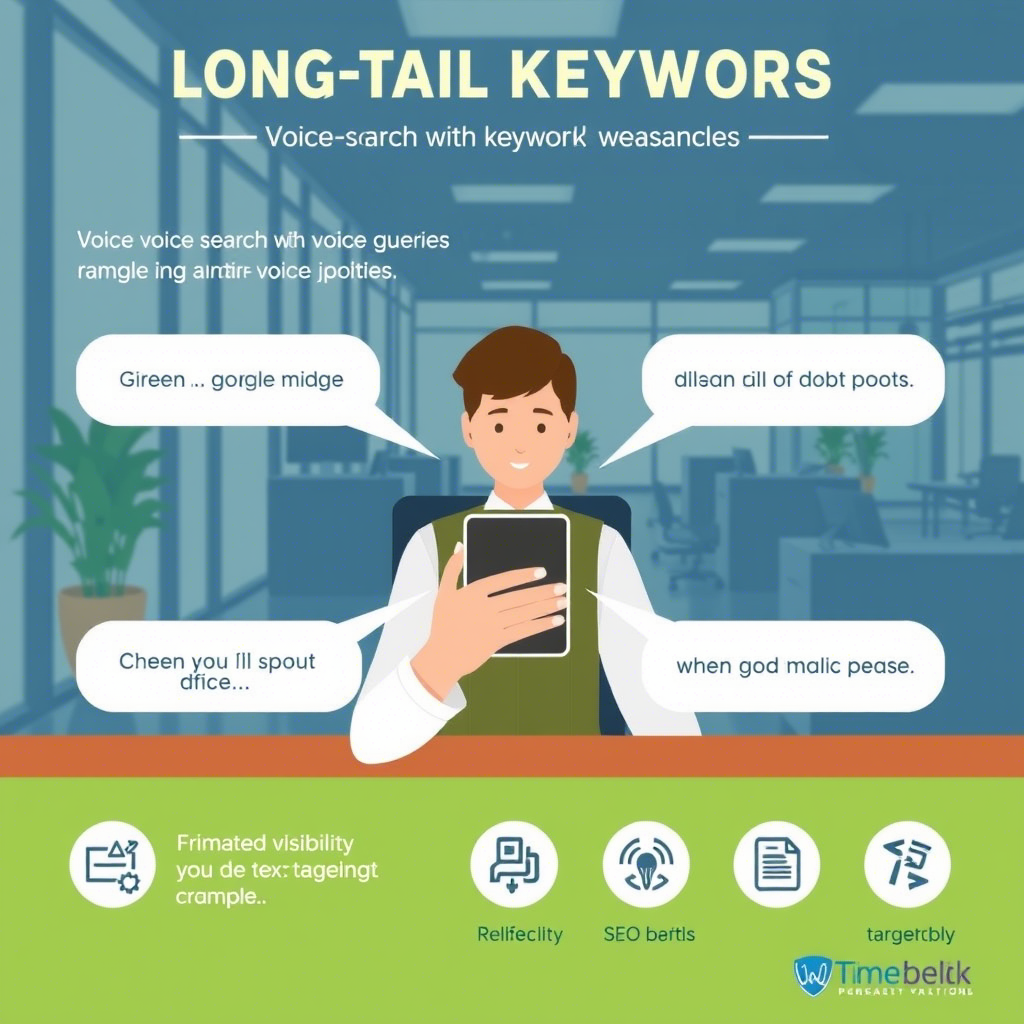In a world where people are increasingly asking their devices questions like “What’s the best Italian restaurant near me?” or “How do I fix a leaky faucet?”, traditional SEO strategies are being turned upside down. The rise of voice search is reshaping how we approach digital marketing, and one thing has become crystal clear: long-tail keywords are no longer optional—they’re essential .
As smart speakers, virtual assistants, and voice-enabled apps become more integrated into our daily lives, understanding how to optimize for these new forms of interaction is crucial. Whether you’re running a small local business, managing an e-commerce site, or creating content online, voice search is no longer a futuristic concept—it’s happening now.
But what makes long-tail keywords so important in this evolving landscape? Why should marketers and website owners shift their focus from broad, generic terms to more specific, conversational phrases?
In this article, we’ll explore exactly that. We’ll walk through the rise of voice search, explain what long-tail keywords are (and why they matter), and show you how to use them effectively to stay ahead of the curve. By the end, you’ll have a clear roadmap to optimize your content for voice queries—and capture high-intent traffic before your competitors do.
Let’s dive in.
The Rise of Voice Search and Its Impact on SEO
Voice search isn’t just a passing trend—it’s transforming how users interact with technology and the internet. According to a report by Comscore, 50% of all searches will be voice-based by 2025 . That’s a massive shift, especially when you consider how recently most searches were done entirely through typing.
Smartphones, smart speakers, and AI-powered assistants like Siri, Google Assistant, and Alexa have made it easier than ever for users to get answers without touching a keyboard. This convenience has changed not only how people search but also what they search for.
When someone types a query, they tend to use short, fragmented phrases like “best pizza NYC.” But when speaking, people naturally phrase things differently: “Where can I find the best pizza in New York City tonight?” These longer, more conversational queries are known as long-tail keywords , and they’re at the heart of voice search optimization.
This evolution means that traditional SEO tactics—like targeting short, competitive keywords—are becoming less effective. Instead, brands must adapt to a new kind of search behavior: one that values clarity, context, and natural language.
For businesses, this is both a challenge and an opportunity. Those who understand and implement voice search-friendly strategies today will be better positioned to reach users tomorrow—especially as voice search continues to grow across mobile devices, cars, and home automation systems.
What Exactly Are Long-Tail Keywords?
At its core, a long-tail keyword is a specific, usually longer phrase that visitors are more likely to use when they’re closer to making a purchase or finding exact information. Unlike broad, short keywords (e.g., “shoes” or “SEO tools”), long-tail keywords are more targeted and often reflect real user intent.
Here’s a quick comparison:
You might notice that long-tail keywords are more descriptive and include modifiers like location, features, or buyer personas. Because of this specificity, they typically have:
- Lower search volume
- Less competition
- Higher conversion rates
From a voice search perspective, long-tail keywords align perfectly with how people actually speak. Think about how you ask questions out loud—you don’t say “weather,” you ask, “What’s the weather forecast for Los Angeles this weekend?”
That’s the key difference: voice search mimics real conversation, which is why long-tail keywords are so critical for optimizing content in this new environment.
Why Voice Search Favors Long-Tail Queries
If you’ve ever used a voice assistant like Google Home or Amazon Alexa, you know that the way you talk to them is very different from how you’d type a search query. You’re more likely to ask full sentences like:
- “How do I change the oil in my car?”
- “What time does Target close tonight?”
- “Can I give my dog Benadryl for allergies?”
These are classic examples of natural language queries , which are inherently long-tail in nature.
Search engines like Google have evolved to understand and respond to these complex queries using Natural Language Processing (NLP) and machine learning. Their goal is to provide direct, accurate answers—often in the form of featured snippets or spoken responses—without forcing users to dig through pages of results.
This shift in search behavior means that websites need to rethink how they structure content. If your blog posts or product pages don’t answer these detailed questions clearly and concisely, you’ll miss out on valuable voice search traffic.
Here’s how voice search favors long-tail queries:
They Match Real User Intent
Long-tail keywords reveal exactly what the user is looking for. Someone searching for “best hiking boots for wide feet under $100” is much further along in the buying journey than someone who just types “hiking boots.”
They Help Trigger Featured Snippets
Google often pulls content directly from web pages to answer voice search queries. Pages that rank in featured snippets are far more likely to be read aloud by voice assistants.
They Improve Local Visibility
Voice searches are often location-based (“near me” queries). Optimizing for long-tail, locally relevant phrases helps businesses appear in these high-intent searches.
By incorporating long-tail keywords into your content strategy, you’re not only improving your chances of ranking well—you’re also offering value that aligns directly with how users are interacting with technology today.
How to Find and Use Long-Tail Keywords for Voice Search
Now that you understand the importance of long-tail keywords in voice search optimization, let’s break down how to find and use them effectively.
🔍 Step 1: Understand Your Audience’s Questions
Start by putting yourself in your audience’s shoes. What problems are they trying to solve? What questions do they frequently ask?
Use tools like:
- AnswerThePublic : Visualizes common questions around a topic.
- Google’s “People Also Ask” section : Shows related queries.
- Quora and Reddit : Great sources for real-world questions.
Step 2: Use Voice-Friendly Keyword Research Tools
While traditional SEO tools like Ahrefs and SEMrush are still useful, there are specialized tools designed for voice search optimization:
- AnswerThePublic
- AlsoAsked
- Google Trends
- Screaming Frog + FAQ Miner
These tools help uncover the exact phrasing users are saying out loud, which is invaluable for voice content creation.
Step 3: Create Conversational Content
Once you’ve identified your target long-tail keywords, integrate them into your content in a natural way. Focus on:
- FAQ sections : Answer common questions directly.
- Blog posts written like guides : Structure them around real-life scenarios.
- Video scripts and transcripts : Include spoken keywords for YouTube SEO and voice recognition.
Step 4: Optimize for Featured Snippets
To improve your chances of appearing in voice search results, aim for the featured snippet. Tips include:
- Keep answers concise (ideally under 50 words).
- Use headers like “What Is…”, “How To…”, or “Why…”.
- Format content with bullet points or numbered lists.
- Use schema markup (like FAQPage) to help search engines understand your content.
Step 5: Prioritize Mobile and Local SEO
Many voice searches happen on smartphones, especially while on the go. Make sure your site is:
- Mobile-friendly
- Fast-loading
- Accurate on Google Business (with hours, address, and reviews)
Optimizing for local, long-tail queries like “best dentist in [city]” or “emergency plumber near me” can significantly boost visibility.
Real-World Examples and Success Stories
Still unsure if focusing on long-tail keywords for voice search optimization is worth your time? Let’s look at some real-world examples to see how businesses have benefited.
Case Study: Local Medical Practice
A small dental clinic in Austin, Texas wanted to increase patient appointments through organic search. They noticed many voice queries like “dentist near me open late” or “emergency dentist in Austin.”
They created a dedicated landing page titled “Emergency Dentist in Austin – Open Late & Same-Day Appointments” and included a detailed FAQ section addressing concerns like:
- “What should I do if my tooth cracks?”
- “Are emergency dental visits covered by insurance?”
- “How much does an emergency dentist cost?”
Within six months, the clinic saw a 37% increase in local voice search traffic and a 22% rise in appointment bookings from organic sources.
E-Commerce Example: Online Furniture Store
An online furniture store was struggling to compete with larger retailers for broad keywords like “sofa” or “dining table.” They shifted focus to long-tail keywords such as:
- “Small space living room sofa ideas”
- “Dining tables for apartments under $500”
- “Modern outdoor patio sets for small decks”
They built blog posts and product pages around these topics, structured with FAQs and optimized for featured snippets. Within a year, voice search traffic increased by over 60% , and conversions from those pages rose by 34% .
Takeaway: Small Changes Can Yield Big Results
These examples prove that even minor adjustments—like adding a voice-optimized FAQ or rewriting product descriptions to sound more conversational—can significantly improve your visibility in voice search results.
You don’t need a huge budget or advanced technical skills to start optimizing. Just a willingness to think like your audience and create content that truly answers their questions.
Conclusion: The Future of Search Is Speaking Up
Voice search is no longer a niche feature—it’s a mainstream behavior shaping the future of SEO. And at the heart of this transformation are long-tail keywords , which allow brands to connect with users in a more personal, conversational way.
By embracing long-tail keywords, you’re not only adapting to current trends—you’re positioning your brand to thrive in a world where search is becoming more human.
Whether you’re writing blog posts, building landing pages, or optimizing your Google Business listing, every piece of content should be crafted with voice in mind. After all, the goal of SEO isn’t just to rank higher—it’s to help real people find the answers they need, quickly and easily.
So here’s the question: Are you ready to speak the language of voice search?
Leave a comment below and tell us how you’re preparing your content for the voice-first era—or share your biggest challenge in optimizing for voice search. We’d love to hear from you!
And if you found this guide helpful, don’t forget to share it with your team or network . The future of SEO is already talking—make sure your brand is part of the conversation.




